
Cordia is a genus of flowering plants in the borage family, Boraginaceae. It contains 228 species of shrubs and trees, that are found in tropical and subtropical regions worldwide. Many of the species are commonly called manjack, while bocote may refer to several Central American species in Spanish.
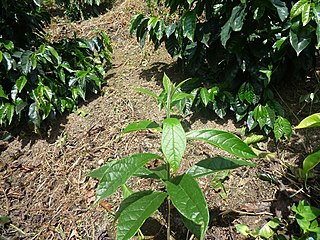
Cordia alliodora is a species of flowering tree in the borage family, Boraginaceae, that is native to the American tropics. It is commonly known as Spanish elm, Ecuador laurel, cypre or salmwood. It can reach 35 m in height.
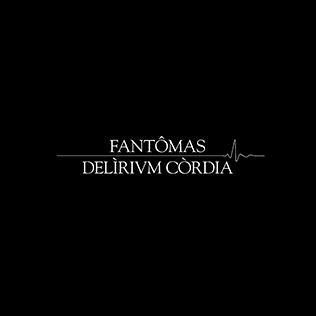
Delìrivm Còrdia is the third studio album by American avant-garde metal band Fantômas, released on January 27, 2004, by record label Ipecac.

Rosewood is any of a number of richly hued hardwoods, often brownish with darker veining, but found in other colours. It is hard, tough, strong, and dense. True rosewoods come from trees of the genus Dalbergia, but other woods are often called rosewood. Rosewood takes a high polish and is used for luxury furniture-making, flooring, musical instruments, and turnery.

Cordia sebestena is a shrubby tree in the borage family, Boraginaceae, native to the American tropics. It ranges from southern Florida in the United States and the Bahamas, southwards throughout Central America and the Greater Antilles. Common names have included siricote or kopté (Mayan) in 19th Century northern Yucatán, scarlet cordia in Jamaica, and Geiger tree in Florida.

The Mitsubishi Cordia is a compact hatchback-coupé manufactured by Mitsubishi Motors between 1982 and 1990. Alongside the Tredia and Starion, the Cordia is one of the first cars imported and sold in the United States by Mitsubishi without the help of Chrysler Corporation, which owned a stake in Mitsubishi and sold its models as captive imports. The Cordia XP was the model sold at the Japanese Car Plaza retail chain, while the Cordia XG was sold at the Galant Shop chain. The Cordia XG model had a somewhat smaller front grille.

The Mitsubishi Tredia is a subcompact sedan built by Mitsubishi Motors from 1982 to 1990. Its name is supposedly derived from Mitsubishi's "Three Diamonds" logo. Alongside the Cordia and Starion, it was one of the first cars imported and sold to America by the company without the involvement of its then partner, the Chrysler Corporation. In Japan, it was sold at a specific retail chain called Car Plaza.
Rodrick Rhodes is an American former professional basketball player who was selected by the Houston Rockets in the first round of the 1997 NBA draft.
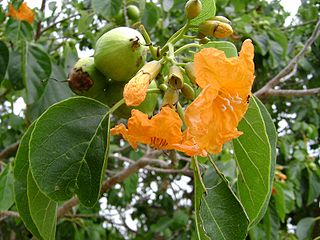
Cordia subcordata is a species of flowering tree in the borage family. It can be found growing in eastern Africa, South Asia, Southeast Asia, northern Australia and the Pacific Islands including Hawaii. The plant is known by a variety of names, including kou, beach cordia, sea trumpet, and kerosene wood.
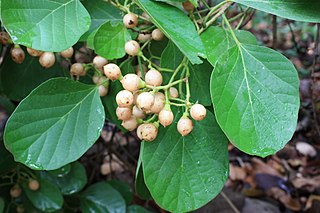
Cordia myxa, the Assyrian plum, is a mid-sized, deciduous tree in the borage family (Boraginaceae), native to Asia. It produces small, edible fruit and is found in warmer areas across Africa and Asia. Other common names in various languages include lasura, leswa,laveda, pidar, panugeri, naruvilli, geduri, sepistan, burgund dulu wanan '"Iriki Chettu (Telugu) and ntege.
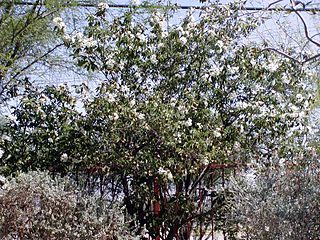
Cordia boissieri is a white-flowered, evergreen shrub or small tree in the borage family (Boraginaceae). Its native range extends from southern Texas in the United States south to central Mexico. Common names include anacahuita, Mexican olive, white cordia, and Texas wild olive. It is named after the Swiss explorer and botanist Pierre Edmond Boissier.

Cordia dichotoma is a species of flowering tree in the borage family, Boraginaceae, that is native to the Indomalayan realm, northern Australia, and western Melanesia.
Dialectica geometra is a moth of the family Gracillariidae. It is known from Hong Kong, Japan, India and Réunion. It has recently been recorded from China.
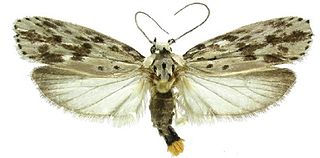
Ethmia lichyi is a moth in the family Depressariidae. It is found in Central and South America, including Venezuela, Brazil, Panama, Costa Rica, Honduras and Guatemala.
Orfina (オルフィーナ) is a fantasy manga written and illustrated by Kitsune Tennouji. It was serialized in the Kadokawa Shoten publication Monthly Comic Dragon from its December 1993 to April 2003 issues before the magazine converted to Monthly Dragon Age, where the manga completed its run from the July 2003 to June 2004 issues. It was also published in North America as part of the CMX label of DC Comics. Orfina is based in the medieval times and rated mature due to nudity, language, violence and suggested situation.
Cordia obliqua, the clammy cherry, is a flowering plant species in the genus Cordia.

Cordia lutea, known as yellow cordia or in Spanish muyuyo, is a shrubby plant in the borage family (Boraginaceae), native to the Galápagos Islands, mainland Ecuador, Peru, and the Marquesas Islands in Polynesia. Common in the arid lowlands of the Galápagos, its relatively large yellow flowers make it easy to identify.
The Tenneru Formation, sometimes in older literature the Tenneru Conglomerate Member of the Chorobetsu Formation, is a geological formation in southeast Hokkaidō, Japan, in the area of Kushiro. Deposited between the Harutori Formation and Yūbetsu Formation in the Urahoro Group that unconformably overlies the Nemuro Group in the Nemuro Belt, the Tenneru Formation correlates with the Rushin Formation at its western end. The Formation, laid down in the Late Eocene, consists mainly of reddish and reddish brown conglomerate, with some sandstone and mudstone; there are several intercalated coal seams. New species of fauna described from the Tenneru Formation include the "Kushiro tapir" [ja], and of flora, Actinidia harutoriensis, Alnus ezoensis, Aralia ezoana, Cordia japonica, Cupania japonica, Idesia kushiroensis, Lastrea kushiroensis, and Maesa nipponica.












